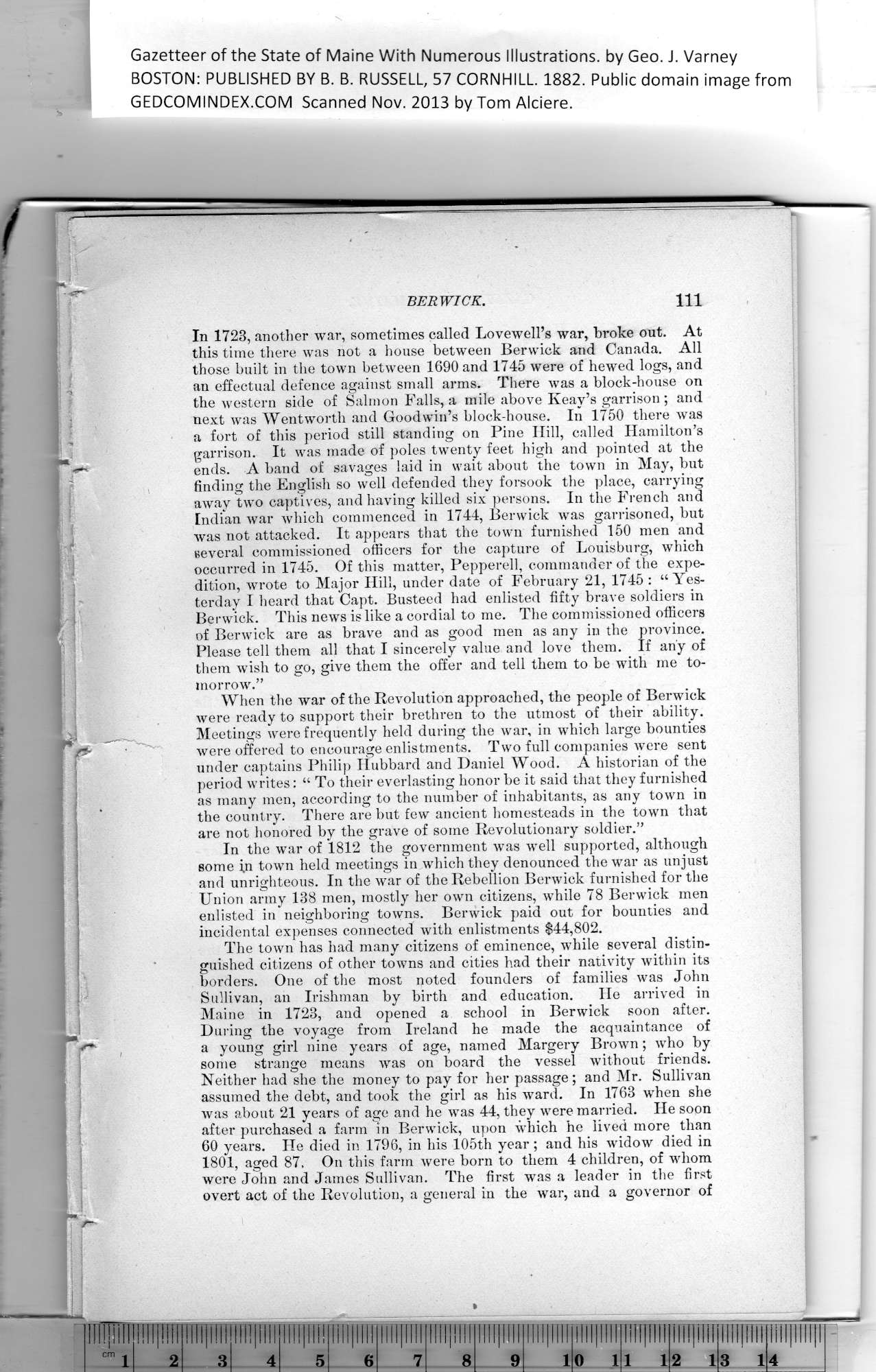|
Gazetteer of the State of Maine With Numerous Illustrations, by Geo. J. Varney
BOSTON. PUBLISHED BY B. B. RUSSELL, 57 CORNHILL. 1882. Public domain image from
BERWICK. HI
In 1723, another war, sometimes called Lovewell’s war, broke out. At
this time there was not a house between Berwick and Canada. All
those built in the town between 1690 and 1745 were of hewed logs, and
an effectual defence against small arms. There was a block-house on
the western side of Salmon Falls, a mile above Keay’s garrison ; and
next was Wentworth and Goodwin’s block-house. In 1750 there was
a fort of this period still standing on Pine Hill, called Hamilton’s
garrison. It was made of poles twenty feet high and pointed at the
ends. A band of savages laid in wait about the town in May, but
finding the English so well defended they forsook the place, carrying
away two captives, and having killed six persons. In the French and
Indian war which commenced in 1744, Berwick was garrisoned, but
was not attacked. It appears that the town furnished 150 men and
several commissioned officers for the capture of Louisburg, which
occurred in 1745. Of this matter, Pepperell, commander of the expe-
dition, wrote to Major Hill, under date of February 21, 1745 : “Yes-
terday I heard that Capt. Busteed had enlisted fifty brave soldiers in
Berwick. This news is like a cordial to me. The commissioned officers
of Berwick are as brave and as good men as any in the province.
Please tell them all that I sincerely value and love them. If any of
them wish to go, give them the offer and tell them to be with me to-
morrow.”
When the war of the Revolution approached, the people of Berwick
were ready to support their brethren to the utmost of their ability.
Meetings were frequently held during the war, in which large bounties
were offered to encourage enlistments. Two full companies were sent
under captains Philip Hubbard and Daniel Wood. A historian of the
period writes: “ To their everlasting honor be it said that they furnished
as many men, according to the number of inhabitants, as any town in
the country. There are but few ancient homesteads in the town that
are not honored by the grave of some Revolutionary soldier.”
In the war of 1812 the government was well supported, although
some in town held meetings in which they denounced the war as unjust
and unrighteous. In the war of the Rebellion Berwick furnished for the
Union army 138 men, mostly her own citizens, while 78 Berwick men
enlisted in neighboring towns. Berwick paid out for bounties and
incidental expenses connected with enlistments $44,802.
The town has had many citizens of eminence, while several distin-
guished citizens of other towns and cities had their nativity within its
borders. One of the most noted founders of families was John
Sullivan, an Irishman by birth and education. He arrived in
Maine in 1723, and opened a school in Berwick soon after.
During the voyage from Ireland he made the acquaintance of
a young girl nine years of age, named Margery Brown; who by
some strange means was on board the vessel without friends.
Neither had she the money to pay for her passage; and Mr. Sullivan
assumed the debt, and took the girl as his ward. In 1763 when she
was about 21 years of age and he was 44, they were married. He soon
after purchased a farm in Berwick, upon which he lived more than
60 years. He died in 1796, in his 105th year; and his widow died in
1801, aged 87. On this farm were born to them 4 children, of whom
were John and James Sullivan. The first was a leader in the first
overt act of the Revolution, a general in the war, and a governor of
PREVIOUS PAGE ... NEXT PAGE
This page was written in HTML using a program written in Python 3.2
|
